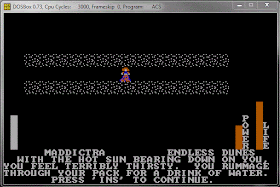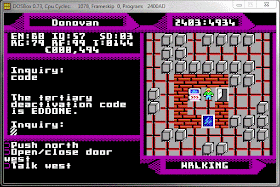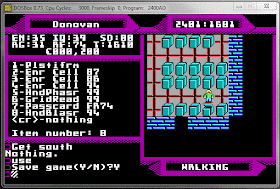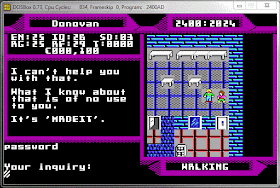Pull up your chairs, kids, and join me for a lesson in the history and mythology of Mesopotamia.
In my last posting, I was just getting acclimated to "Rivers of Light" and had solved my first series of quests. With the proceeds, I was able to buy my first armor, a "billowy shirt." I found a cache of bee honeycombs that each sold for 20 sacks of barley (the unit of currency in this game), with the drawback that I can only carry one at a time and have to fight a bear every time. Nonetheless, I collected and sold enough to outfit myself with a proper sword.
My swimming skill enabled me to cross the Tigris river to the city-state of Great Assur (which you may remember from high school as the capital of ancient Assyria).
A woodsman told me of several regional problems, including a statue of a winged bull that recently came to life, and a fearful beast called Humbaba. It's nice when all of your side-quests in a given area are announced at the outset. Other plaques and people nearby fleshed out the backstories of these three threats.

The winged bull statue turns out to have been a representation of Shedu, a Babylonian deity. Shamash, the God of Justice in Babylonia, brought it to life, and it flew off with the doorman to the Royal Library, along with the doorman's key. Shedu proved to be a bit difficult. It killed me a bunch of times before I decided to retire to the original area and boost my skills a bit before attempting it again. In the midst of this, I discovered that some "red clay clods" I had previously found actually boost your health significantly before battle. Using one of these, Shedu became a bit easier. Oddly, it respawned after I killed it, but I didn't need to fight it again since I had found on the first corpse the Royal Key.

Humbaba is mentioned in the Sumerian Epic of Gilgamesh as a giant guarding the Cedar Forest who is slain by the hero. The first few times I approached him, he killed me with a spell, but after I received a sun amulet from the god Shamesh by leaving some bee honey on his altar, I was able to kill him, and I got a cedar pole in return. No idea what this is about.
The dragon is called Yam, a Canaanite god of river and sea. According to Wikipedia, he is associated with storms and storm-related disasters. Although not specifically described as a dragon in Canaanite mythology, Wikipedia says his analog in Babylonian mythology is Tiamat, who of course becomes a dragon in Dungeons & Dragons mythology. A plaque in the game told me he could only be defeated through a "weapon of Sir Adroit and Cunning's." Having no idea where to find this, I was forced to move on.

In the library--which turned out to be none other than Assyrian King Assurbanipal's Great Library of Knowledge (which still survives today as a ruin in Nineveh)--I exchanged the Royal Key for a spell called "Shabrir Begone" and some of my grain for a broken tablet, which read: "To pass the first gate, one must take a regal key to the glyph room. There one must... [the rest garbled]." More important, I read a series of tapestries recording messages from the great god Ea that heretics have stolen "three great shapes" and used them "as profane keys of passage through a mysterious trio of gates." There's also a note about Gilgamesh, who was seeking the secret of immortality himself to heal his friend Enkidu; and also one about Utnapishtim, who saved humanity from the Great Flood and now lives forever. Sounds like I'm getting closer to my quest!

In the Arabian Desert, I killed a bandit and took his camel, which allowed me to cross the Sinai peninsula into Egypt. Crossing the Sinai Desert meant staying constantly hydrated, which was tough because the water along the way was possessed by Shabriri demons; fortunately, I had the "Shabriri Begone" spell from the library and was able to force them to take physical form and kill them.

On the other side of the Sinai, I found the great pyramid at Gizeh, rife with thieves who stole everything not nailed down, including my camel.

The pyramid held so many references to different mythologies (including a pre-Mummy shout-out to Imhotep) that even I got sick of looking them up on Wikipedia. This is where I left the game for the night.

Two notes on gameplay, though, that I missed to tell you in my first posting on Adventure Construction Set: first, there are two types of weapons, melee and missile. For melee weapons, I've gone through a large bone, a flint knife, a sword, and now an iron sword. For missile weapons, I've found rocks and bows. You have an associated skill with each that increases as you score hits.
Second, this is the first game I know (although I'm probably just forgetting one) to attach a weight to the items in your inventory. There's a little "movement" bar on the left-hand side of the screen that gets shorter as you carry more stuff. Eventually, you can't move unless you drop some of it. Unfortunately, it counts your barley (the game's currency) as weight, so you can't get too rich.
My melee skill has already maxed out at 100, which is a good sign that the game isn't going to last that much longer. If the next post is a "Won!" you'll know I was right.











































